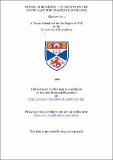Files in this item
Mining subsidence: its effects on the South-East Fife coastline, Scotland
Item metadata
| dc.contributor.advisor | Whittington, G. | |
| dc.contributor.author | Saiu, Elisabeth | |
| dc.coverage.spatial | 269 p. , 6 p. | en_US |
| dc.date.accessioned | 2018-07-18T16:23:28Z | |
| dc.date.available | 2018-07-18T16:23:28Z | |
| dc.date.issued | 1999 | |
| dc.identifier.uri | https://hdl.handle.net/10023/15553 | |
| dc.description.abstract | This thesis is concerned with the impact of coal mining activities upon the coastal zone of southeast Fife. Coastal changes over a 100 year period from 1894 to 1996 have been evaluated by determining the plan variation of the High Water and Low Water datum recorded on different editions of large scale Ordnance Survey (O.S.) Plans of the area. Deposition and erosion implied by the movement of the tidal datum are related to the longshore dispersal of spoil deposition from the coastal bings (1) and to mining subsidence. Mining subsidence is evaluated using the Surface Deformation Prediction System (SDPS), previously used at sites in the United States, and now applied for the first time to a United Kingdom coalfield. A new technique is developed that enables the subsidence values to be generated along O.S. co-ordinates at 10m intervals. Subsidence values are recorded with an accuracy of ±20% along the tidal marks of 1894, 1914, 1960, 1994 and 1996. Between Buckhaven and Dysart the coastline is found to have subsided with only small pockets having been left unaffected. Indeed, in the West Sands Bay area a subsidence trough with a maximum of 5.7+l.lm is calculated. The extent of recent coastal erosion along the shore can be seen to correlate with predicted subsidence over different mining panels and thus confirms the importance of this factor upon the coastal process in south-east Fife. These results are reinforced by comparing bench-mark heights against subsidence values producing a correlation coefficient of 0.9. The state of the pre-mining coastline is evaluated using historic documents and photographs. This provides a starting point for evaluating the changes wrought on the coastline by the large scale mining activities which commenced about 1898 and terminated with the closure of the Frances colliery in 1984. Following this, the extent of coastal change from the analysis of O.S Plans is presented. Subsequent chapters evaluate the possible factors which may have caused the observed coastal changes including long term changes, land uplift or subsidence following the last glaciation, mining activities and possible sea level changes due to global warming. To ensure the greatest possible accuracy in the determination of coastal changes against subsidence data a rigorous GIS is employed to analyse both map and mining data allowing for registrations to be obtained between the different surveys. This involves the manipulation of both vector and raster data from the O.S. plans and the SDPS software requiring the laborious and lime consuming transfer of data between different computer platforms. Despite this caveat this novel method is demonstrated, in the thesis, to be a flexible and precise method which can be applied to any given site for the accurate prediction of mining subsidence. 1: Bing is the Scottish phrase for slag heap. | en_US |
| dc.language.iso | en | en_US |
| dc.publisher | University of St Andrews | |
| dc.subject.lcc | QE264.F5S2 | |
| dc.subject.lcsh | Geology--Scotland--Fife | en |
| dc.title | Mining subsidence: its effects on the South-East Fife coastline, Scotland | en_US |
| dc.type | Thesis | en_US |
| dc.contributor.sponsor | Fife Regional Council | en_US |
| dc.type.qualificationlevel | Doctoral | en_US |
| dc.type.qualificationname | PhD Doctor of Philosophy | en_US |
| dc.publisher.institution | The University of St Andrews | en_US |
This item appears in the following Collection(s)
Items in the St Andrews Research Repository are protected by copyright, with all rights reserved, unless otherwise indicated.

